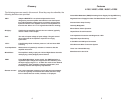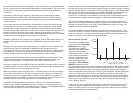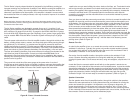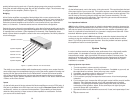
the heat from the components to the heatsink. The heatsink, in turn, must dissipate this
heat or become too hot for the internal components to operate properly. The heat can be
transferred from the heatsink by three different processes: Conduction, Radiation, or
Convection.
Conduction is defined as the process by which heat is transferred through matter,
without transfer of the matter itself A practical example of this would be the cooling
system in your car which circulates a liquid (matter) in order to transfer the heat away
from your engine.
In the mobile environment, conduction is not the primary process of transferring heat
from the heatsink. The use of a circulating liquid or gas is impractical, unless specific
p
rovisions were made in the design of a heatsink to accomodate this type of transfer.
There is nothing in the vehicle which could easily be used to heatsink the heatsink. Air is
the only (practical) conductive (heat transfer) medium involved when you install an
amplifier in your car. As we will discuss later, heat radiated by the heatsink is conducted
out into the environment, triggering the process of convection.
Radiation is defined as the process of giving out light, heat, or other radiant energy. An
example of this process would be the sun. It radiates heat, light, and other radiant
energy.
Radiation is the primary process of heat transfer for a heatsink. As the conducted heat
builds (from the internal components), it radiates from the surface out into the
surrounding environment. The amount of heat radiated by the heatsink is determined by
its surface area. The traditional way to add surface area is to use fins, expanding the
radiating surface without increasing the overall dimensions of the amplifier.
So why doesn't the Art Series heatsink employ the traditional use of fins since it must
adhere to the same rules of thermodynamics that all other heatsinks do? We must
discuss the third process - convection before the answer will become clear.
Convection is defined as the transfer of heat from one place to another by the movement
of heated particles of a gas or liquid. An example of this process would be warming your
hand by holding it in the hot air rising from an oven.
When an amplifier's heatsink becomes warm, it conducts heat out into the surrounding
environment, warming the air. The warm air begins to rise, creating air currents which
draw heat away from the heatsink. With a traditional finned heatsink, this process is
most effective when the amplifier is mounted on its vertical axis. As with chimney, the air
circulates upward, over the fins, improving the heat transfer process.
Your ability to take advantage of convection is limited by the installation constraints
imposed by the mobile environment. Mounting an amplifier on the vertical axis is not
always possible and generally, not preferred (by the consumer). The amplifier's heatsink
is left with only one primary process for heat transfer - radiation.
Engineers have recognized the importance of radiant surface area, but the constraints o
f
the automotive environment have forced heatsink designs to remain compact. In order to
improve radiating efficiency, designers have simply added more fins. With limited space,
adding more fins means that they get closer together What PPI's engineers observed
was that fins in c lose proximity radiate heat from fin to fin rather than into the
environment. If convection is not available to draw the heat out from between the fins,
the heat becomes trapped, causing a reduction in radiant heat transfer efficiency.
The Art Series heatsink addresses this problem and improves radiant heat transfer
efficiency by providing more effective radiating surface area. Combined with our highly
efficient (less wasted energy in the form of heat) PWM power supply, the result is an
amplifier with improved thermal capabilities.
A
s with any amplifier, care must be taken when selecting a mounting location. There
must be two inches of air space around the heatsink for proper heat dissipation to take
p
lace. If mounting in an enclosed area, a fan may be added to improve heat transfer.
RefertotheSectiononInstallationformoreinformation.
A
M II Protection Circuitry
A
ll Art Series amplifiers utilize
ahighly-efficient,Pulse-Width
Modulated power supply.
This means the amplifier
will continue to operate within
regulation until the battery
voltage drops below 11 volts
or the heatsink temperature
reaches 75 degrees Celsius.
This new power supply also
incorporates the second
generation of PPI's Adaptive
MOSFET protection circuitry.
This advanced protection circuit was developed to prevent shut-off due to the fluctuating
impedance loads presented by today's complex speaker systems. The adaptive circuit
optimizes output power to maintain uninterrupted operation whenever the amplifier
senses an impedance load of less than 2 Ohms. A low impedance indicator (Diagnostic
L.E.D.) is provided to let you know when the amplifier is operating in this mode. It is
important to note that there is no increase in output power below the 2 Ohm threshold.
Maximum power is achieved at 2 Ohms. AM II provides you the satisfaction of knowing
that your Art Series amplifier will continue to play when momentary impedance dips
occur.( Refer to figure A )
In the case of a short circuit, AM II will engage to protect the shorted channel but will
continue to play the unaffected channel. When this occurs, audible distortion will be
heard. Turn off the system and repair the short. Once the problem has been repaired,
the amplifier will return to normal operation.
Watts
100
50
25
Ohms
8 4 2 1 0.5
Figure A: AM II Protection Circuitry
Output Power vs. Impedance
8 9













